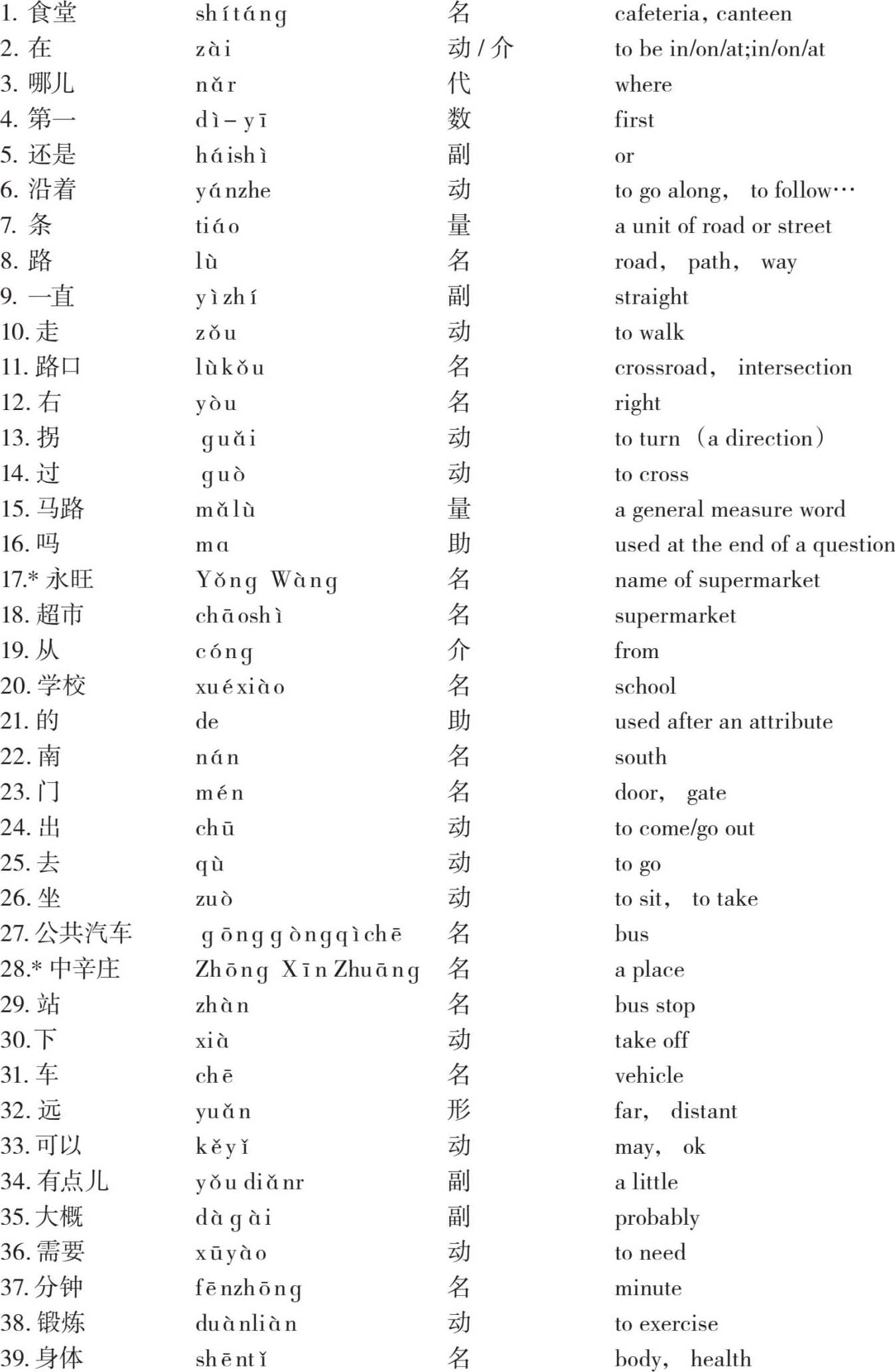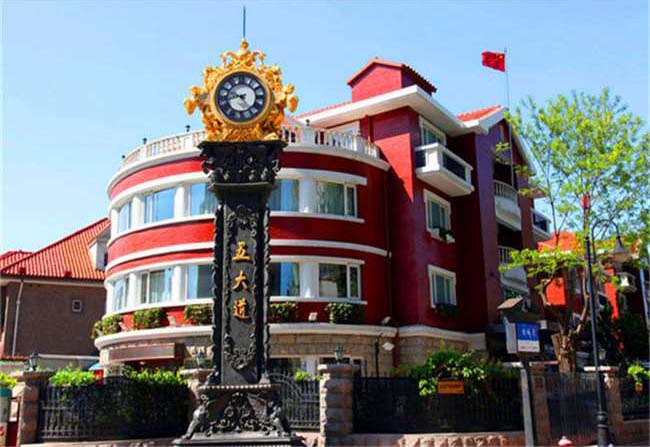





1.食堂在哪儿?Where is the cafeteria?
2.第一食堂还是第二食堂?Cafeteria No.1 or No.2?
3.你沿着这条路一直走,在第一个路口右拐,就能看到第一食堂了。Go along the road,take the first turning on the right,you will see Cafeteria No.1.
4.从学校的南门出去,坐629路或者704路公交车,在中辛庄站下车。Go out from the southern main entrance,take the bus No.629 or No.704,and get off at Zhong Xin Zhuang.
张雨:李萍,食堂在哪儿?
Zhānɡ Yǔ:Lǐ Pínɡ,shí tánɡ zài nǎr?
李萍:第一食堂还是第二食堂?
Lǐ Pínɡ:Dì-yī shí tánɡ hái shì dì-èr shí tánɡ?
张雨:第一食堂吧。
Zhānɡ Yǔ:Dì-yī shí tánɡ bɑ。
李萍:你沿着这条路一直走,在第一个路口右拐,就能看到第一食堂了。
Lǐ Pínɡ:Nǐ yán zhe zhè tiáo lù yì zhí zǒu,zài dì yī ɡe lù kǒu yòu ɡuǎi,jiù nénɡ kàn dào dì-yī shí tánɡ le。
张雨:沿着这条路一直走,在第一个路口右拐。过马路吗?
Zhānɡ Yǔ:Yán zhe zhè tiáo lù yì zhí zǒu,zài dì yī ɡe lù kǒu yòu ɡuǎi。Guò mǎ lù mɑ?
李萍:不过马路。
Lǐ Pínɡ:Bú ɡuò mǎ lù。
张雨:好,谢谢!
Zhānɡ Yǔ:Hǎo,xiè xie!
李萍:不客气。
Lǐ Pínɡ:Bú kè qi。
大卫:老师,请问,永旺超市在哪儿?
Dà Wèi:Lǎo shī,qǐnɡ wèn,Yǒnɡ Wànɡ chāo shì zài nǎr?
张老师:从学校的南门出去,坐629路或者704路公共汽车,在中辛庄站下车。
Zhānɡ lǎo shī:Cónɡ xué xiào de nán mén chū qù,zuò liù èr jiǔ lù huò zhě qī línɡ sì lù ɡōnɡ ɡònɡ qì chē,zài Zhōnɡ Xīn Zhuānɡ zhàn xià chē。
大卫:远吗?老师。
Dà Wèi:Yuǎn mɑ?Lǎo shī。
张老师:不远,4站就到了。
Zhānɡ lǎo shī:Bù yuǎn,sì zhàn jiù dào le。
大卫:老师,我走路去,可以吗?
Dà Wèi:Lǎo shī,wǒ zǒu lù qù,kě yǐ mɑ?
张老师:走路有点儿远,你从南门出去,右拐,一直走,大概需要40分钟。
Zhānɡ lǎo shī:Zǒu lù yǒu diǎnr yuǎn,nǐ cónɡ nán mén chū qù,yòu ɡuǎi,yì zhí zǒu,dà ɡài xū yào sì shí fēn zhōnɡ。
大卫:没关系,我走路去,锻炼身体。谢谢老师!
Dà Wèi:Méi ɡuān xì,wǒ zǒu lù qù,duàn liàn shēn tǐ。Xiè xie lǎo shī!

“不(bù)”在第一、二、三声音节前不变调;在第四声音节前变成第二声(bú)。When“不(bù)”is followed by a syllable in the first,second or third tone,its tone doesn't change; when followed by a fourth tone,it changes into the second tone(bú)。
bù chī bù lái bù zǒu
bú huì
“一(yī)”在第一、二、三声音节前变成第四声(yì);在第四声音节前变成第二声(yí)。When“一(yī)”is followed by a syllable in the first,second or third tone,it changes into the fourth one(yì); when followed by a fourth tone,it changes into the second tone(yí)。
yì tiān yì nián yì běn
yí jiàn
“er”常常和其他韵母结合在一起,变成“儿化音”。书写汉字时,用“汉字+儿”表示;书写拼音时,在原韵母后加“-r”。“er”is often added to another final to make it retroflexed.It is written as“character+儿”and spelt as“syllable + r”in pin yin.
花儿(huār) 一点儿(yì diǎnr)
Yi nián zhī jì zài yú chūn。 一年之计在于春。
Yi rì zhī jì zài yú chén。 一日之计在于晨。
Yi jiā zhī jì zài yú hé。 一家之计在于和。
Yi shēn zhī jì zài yú qín。 一身之际在于勤。
The planning of the year's work begins with spring.
The planning of the day's work begins with morning.
The key to family life is harmony.
The key to a successful career is diligence.
ér tónɡ儿童 nǚ’ér女儿
yí huìr一会儿 yí xiàr一下儿
huār花儿 wánr玩儿
xiǎo háir小孩儿 bīnɡ ɡùnr冰棍儿
五大道风景区,以马场道、睦南道、大理道、重庆道、成都道五条主要街道而得名。风景区共有22条道路,总长17km,占地1.28平方公里。五大道风景区内有超过2000栋的建于1920年代和1930年代的花园式建筑,还有300余所名人故居。五大道风景区是世界公认的近代建筑优秀示范区,您可以租自行车或乘马车观光游览,感受天津历史文化的美。
Five Avenue Scenic Zone is famous for its five avenues, including Machang Avenue, Munan Avenue, Dali Avenue, Chongqing Avenue and Chengdu Avenue.There are altogether 22 roads with a total length of 17 kilometers and an area of 1.28 square kilometers.There are over 2, 000 garden-style architectures built in 1920s and 1930s, and more than 300 residences belong to former celebrities.Five Avenue Scenic Zone is globally acknowledged as an outstanding model of modern architecture zone.
